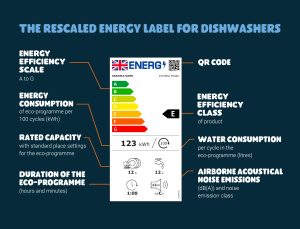Learning to understand the new rating system on energy labels is a great problem to have. With advancements in energy efficiency and environmental sustainability, energy labels have had to adapt with the times to help us continue to make smart, informed choices. It’s a sign of progress, but it’s one we must all take time to understand as consumers.
The recent overhaul of energy rating labels, thankfully, simplifies the process, offering consumers clearer information and promoting the use of energy-efficient white goods. Let’s take a look at the recent changes and what they mean for you and your energy bills.
The shift in energy labels on appliances was necessitated by the need for clearer and more effective identification of energy-efficient products. The previous rating scale, ranging from A+++ to G, was becoming less accurate with time, as most modern appliances occupied the top categories, rendering the lower grades obsolete, making it challenging to distinguish the most energy-efficient options.
The updated labels, now ranging from A to G, provide a simpler and clearer system for consumers to evaluate energy efficiency.
The new energy label features a simplified range from A to G. For products like refrigerators, freezers, washing machines and others, the updated labels provide a comprehensive overview of energy consumption, allowing consumers to choose more energy-efficient options.
Here is the new energy A-G scale, compared to the older rating system, to help you make a comparison:
- A+++ = Now rated as B or C
- A++ = Now rated as D or E
- A+ = Now rated as F or G
This varies from product to product, along with product type. This scope allows for future developments, as more and more energy efficient technology emerges. This means that LEAP Appliance Scheme products (the equivalent of the old A+ rating, now F or G) will be more efficient than your outdated appliances at home.
The revised energy labels feature essential details such as energy consumption metrics, simplified energy efficiency classes from A to G, and additional icons for enhanced clarity.
Additionally, consumers can now scan a QR code on the label to access even more product information, providing a comprehensive understanding of each appliance’s energy performance.

The new energy rating labels will gradually roll out across various products, including domestic refrigerators, freezers, washing machines, dishwashers, TVs, and light sources. Thenew labels aimto ensure that consumers have access to accurate and transparent information about the energy efficiency of these commonly used household appliances.
The product categories affected by the label change are:
- Refrigerators and freezers
- Wine storage refrigerators
- Washing machines
- Washer-dryers
- Dishwashers
- TVs and electronic displays
- Light sources
When selecting new white goods, look for products with higher energy efficiency ratings, indicated by classifications closer to ‘A’ on the new label. By opting for appliances with superior energy ratings, you can reduce long-term running costs, minimise carbon emissions, and contribute to a more sustainable lifestyle.
If you’re considering upgrading your appliances to more energy-efficient models, various resources and support systems are available to guide you through the process.
Initiatives like the LEAP Appliance Scheme provide valuable assistance to households seeking cost-effective solutions and sustainable living practices. By accessing programmes like the LEAP Appliance Scheme, eligible individuals can benefit from energy-efficient white goods such as fridges, washing machines, and cookers, promoting energy savings and environmental responsibility.
The new energy rating labels on white goods signify a positive shift towards greater energy awareness and environmentally conscious consumer choices. If you’d like to check your eligibility for energy-efficient appliance upgrades to your home, see the LEAP Appliance Scheme.
*Please note, due to high demand the LEAP Appliance Scheme is currently subject to availability*



